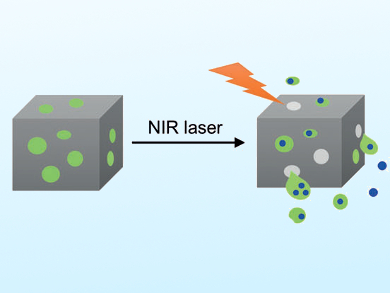Hypoxic Cancer Cells
Most tumors contain regions of low oxygen concentration where cancer therapies based on the action of reactive oxygen species are ineffective. American scientists have developed a hybrid nanomaterial that releases a free-radical-generating prodrug inside tumor cells upon thermal activation. As they report in the journal Angewandte Chemie, the free radicals destroy the cell components even in oxygen-depleted conditions, causing apoptosis. Delivery, release, and action of the hybrid material can be precisely controlled.
Many well-established cancer treatment schemes are based on the generation of reactive oxygen species (ROS), which induce apoptosis in the tumor cells. However, this mechanism only works in the presence of oxygen, and hypoxic (oxygen-depleted) regions in the tumor tissue often survive the ROS-based treatment. Therefore, Younan Xia, Georgia Institute of Technology and Emory University, Atlanta, USA, and his team have developed a strategy to deliver and release a radical-generating prodrug that, upon activation, damages cells by an ROS-type radical mechanism, but without the need for oxygen.
Hybrid Nanocages for Targeted Delivery
The researchers explain that they had to turn to the field of polymerization chemistry to find a compound that produces enough radicals. There, the azo compound AIPH is a well-known polymerization initiator. In medicinal applications, it generates free alkyl radicals that cause DNA damage and lipid and protein peroxidation in cells even under hypoxic conditions. However, the AIPH must be safely delivered to the cells in the tissue. Thus, the scientists used nanocages, the cavities of which were filled with lauric acid, a so-called phase-change material (PCM) that can serve as a carrier for AIPH. Once inside the target tissue, irradiation by a near-infrared laser heats up the nanocages, causing the PCM to melt and triggering the release and decomposition of AIPH.
This concept worked well, as the team has shown with a variety of experiments on different cell types and components. Red blood cells underwent pronounced hemolysis. Lung cancer cells incorporated the nanoparticles and were severely damaged by the triggered release of the radical starter. Actin filaments retracted and condensed following the treatment. And the lung cancer cells showed significant inhibition of their growth rate, independently of the oxygen concentration.
Although the researchers admit that “the efficacy still needs to be improved by optimizing the components and conditions involved,” they have demonstrated the effectiveness of their hybrid system in killing cells, also in places where the oxygen level is low. This strategy might be highly relevant in nanomedicine, cancer theranostics, and in all applications where targeted delivery and controlled release with superb spatial/temporal resolutions is desired.
- A Hybrid Nanomaterial for the Controlled Generation of Free Radicals and Oxidative Destruction of Hypoxic Cancer Cells,
Song Shen, Chunlei Zhu, Da Huo, Miaoxin Yang, Jiajia Xue, Younan Xia,
Angew. Chem. Int. Ed. 2017.
DOI: 10.1002/anie.201702898




